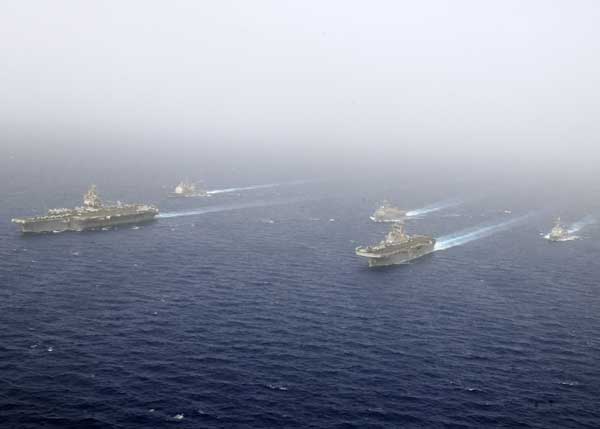2013-01-31 By Col. Bradley Weisz, Deputy Commander, Expeditionary Strike Group TWO, United States Fleet Forces Command, Little Creek, Virginia
“I believe that our nation needs fast, austere and lethal expeditionary naval forces that can execute missions across the spectrum of conflict. The Navy-Marine Corps team is that key.”
In 2008, the Commandant of the Marine Corps, General Conway, directed his Marines to return to their amphibious roots and traditional roles as “fighters from the sea.” After supporting many years of land combat in Iraq, Afghanistan and the Horn of Africa, General Conway desired for the Corps to revitalize its famed naval heritage.
“When I go to meetings and I hear Army and Marine Corps talked about in the same breath, I get uncomfortable. It should be Navy and Marine Corps. We are most comfortable deploying as an expeditionary force afloat. One day, again, it will be.”
The Case of the KEARSARGE ARG/26th MEU
Well General Conway, that day has come.
At the Amphibious Ready Group/Marine Expeditionary Unit (ARG/MEU) level, the Navy and Marine Corps are excelling in their day-to-day sea-faring missions. In fact, the ARG/MEUs never really lost their amphibious roots; evident by the recent accomplishments of the KEARSARGE ARG/26th MEU (KSG ARG/26 MEU) deployment.
The KSG ARG/26 MEU deployed 30 days early when the United States Transportation Command (USTRANSCOM) utilized strategic airlift to transport four of its CH-53E heavy-lift helicopters into Pakistan in support of severe flooding and humanitarian assistance/disaster relief (HA/DR) efforts.
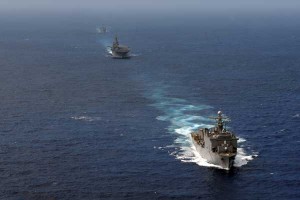
Right on the heels of the Pakistani HA/DR mission, the KSG ARG/26 MEU conducted numerous theater security cooperation (TSC) exercises and engagements with many of the Arab Gulf Cooperation Council countries as well as several other countries in the Middle East and Africa.
With little to no notice but relying heavily on the its well-developed and time tested rapid response planning process (R2P2), the KSG ARG/26 MEU successfully conducted counter-piracy (CP) operations off the coasts of Yemen and Somalia.
Finally, the KSG ARG/26 MEU quickly transitioned from TSC and CP missions to major combat operations and conducted highly decisive lethal and non-lethal strikes in both Afghanistan and Libya; emphasizing the critical importance of habitual blue-green relationships and the strength of the combined arms, air-ground-logistics team of the Marine Air Ground Task Force (MAGTF).
ESG/MEB Progress
Additionally, at the Expeditionary Strike Group/Marine Expeditionary Brigade (ESG/MEB) level, Navy and Marine Corps personnel have made huge progress in their training, education and certification efforts as a result of the planning, coordination and execution of large scale amphibious exercises such as BOLD ALLIGATOR, DAWN BLITZ and PHIBLEX.
The opportunities for the blue-green team to continuously engage each other and work through the critical supported/supporting command relationships enabled a close partnership to be developed and maintained between the ESGs and MEBs.
Focusing on the single naval battle initiative, composite warfare commander (CWC) construct, defense of the amphibious task force (DATF) objectives and newly established sea-basing procedures, ESGs and MEBs were able to reinvigorate their knowledge and understandings of the difficulties and intricacies associated with large scale amphibious operations.
The Blue-Green Team Must Not Stop There
The Navy and Marine Corps must not become complacent and stop right there.
Leveraging the lessons learned of the past ten years in combat and seeking innovative solutions to tomorrow’s littoral problems, the Navy and Marine Corps should aggressively develop short-term, mid-term and long-term objectives in order to continue to optimize the capabilities of the unique blue-green team. They should develop a plan of action with objectives to start small, get bolder and finally, push the envelope for continued progress.
“The amphibious warship is without question the most utilitarian ship in the fleet. I have heard the CNO say that, and I certainly agree.”
Start Small
First and foremost, the Office of the Chief of Naval Operations (OPNAV) and Headquarters Marine Corps (HQMC) must continuously stress to our senior civilian and military leadership the vital importance that amphibious warfare capabilities provide to our nation and our regional combatant commanders.
Our blue-green strategic communications (STRATCOMMS) must always highlight the flexibility, responsiveness and versatility that amphibious forces provide to commanders and decision makers on a daily basis.
“It is people who make the difference. Tanks, ships, airplanes and rifles are all important tools; but without the right people, they’re useless.”
General Carl E. Mundy, Jr., 217th USMC Birthday Ball Speech, Washington D.C., November 10, 1992.
Another way to optimize the blue-green team is to put more Marines back on board our amphibious warships (amphibs).
Currently the Navy has twenty-nine amphibs, consisting of nine amphibious assault ships (LHA/LHDs), eight amphibious transport docks (LPDs) and twelve dock landing ships (LSDs).
On board the LHA/LHDs, only five Marines are permanently assigned to the ship’s company of approximately eleven hundred naval personnel; on board the LPDs, only three Marines are permanently assigned to the ship’s company of approximately four hundred naval personnel; on board the LSDs, specifically the HARPERS FERRY class LSDs, only two Marines are permanently assigned to the ship’s company of approximately four hundred naval personnel.
The blue-green team can do much better than this.
Potential areas or occupational specialties where more Marines could be assigned to amphibs include aviators, aviation command and control (Air C2/ controllers), civil affairs, communications, fires, public affairs and weather personnel.
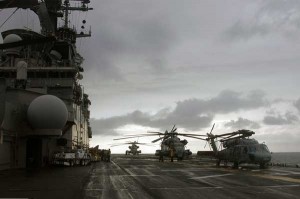
These particular skill sets would be in high demand and usage on all amphibs in service right now.
The integration of Marines into the Navy’s ESG staff has been crucial in providing operational planning expertise as well as maintaining close, effective partnerships between ESGs and MEBs.
An example of this effective planning and integration was the development of ESG-2’s STRATCOMMS plan for the East Coast amphibious fleet. This STRATCOMMS plan was a combined blue-green effort, but primarily led by Marines on the ESG staff. This strategic communications plan is provided below.
Using the ESG staff construct as a model for the Marine Corps, it is time for the Navy to start assigning more sailors to the MEB staff.
A dedicated team of surface warfare officers with amphibious experience, surface warfare officers with Cruiser/Destroyer experience and aviators with fixed-wing and rotary-wing experience would be invaluable on a MEB staff; in fact, they would be irreplaceable.
These skill sets are truly missing from the MEB staff and would capably round out a tight ESG/MEB integrated team.
Another way to optimize the blue-green team is to have Carrier Strike Groups (CSGs) start training regularly with ARG/MEUs.
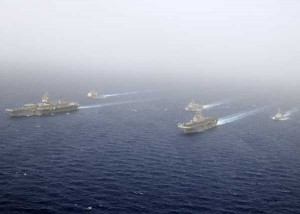
Currently there is no integration or training conducted between an ARG/MEU and a CSG.
This is unbelievable in today’s operating environment where the first responders to an international crisis or conflict have historically been Marines aboard big deck amphibs and sailors aboard large deck aircraft carriers.The Navy and Marine Corps’ primary training organizations must put aside their service parochialisms, come together and establish dedicated, consistent training opportunities between ARG/MEUs and CSGs. In effect, this would be the start of our naval expeditionary forces becoming “brilliant at the basics of maritime operations.”
Our maritime forces must become more integrated; more familiar by working with each other. No longer can we afford a pick-up game in the littorals; the stakes are just too high.
A GATOR Magazine?
The development of an official blue-green “Gator” magazine would be extremely beneficial in capturing the current operations, lessons learned and best practices of the amphibious community. This magazine could be modeled after the Naval Aviation News magazine; the flagship publication of naval aviation.
Focus areas for the “Gator” magazine could include C2, flight deck certifications and operations, well deck certifications and operations, CWC and C5I integration, amphibious task force considerations, landing force considerations, counter-insurgency (COIN) operations in the littoral environment, sea basing options as well as historical and past examples of amphibious operations.
Basically, it would be dedicated to telling the story of blue-green amphibious operations, both past and present. Over the last twenty years, the blue-green team has conducted more than one thousand amphibious operations; approximately one hundred of these have been crisis response operations with the other nine hundred being TSC and engagement events.
The “Gator” magazine would be a great venue to capture these experiences; ultimately providing a needed boost to the amphibious community identity.
Get Bolder
According to General Amos: “With modern aviation, we can provide kinetic strike or responsive maneuver from hundreds of miles out to sea. We can influence events ashore and return to the sea with the same swiftness we arrived. That broad-based utility makes amphibious ships with embarked Marines…the ultimate Swiss Army knife of the Joint force.”
General James F. Amos, Address to the Center for Strategic and International Studies, November 8, 2012
The blue-green team should focus on pursuing and training for disaggregated ARG/MEU operations much more than it has in the past.
Currently the ARG/MEU construct consists of three amphibious warships; one LHA/LHD, one LPD and one LSD; it is also built around a battalion landing team, composite aircraft squadron and combat logistics battalion. The ability to put a small MAGTF capability aboard each amphibious ship is an instant game changer for the combatant commander and would fully support his or her current modus operandi for the ARG/MEU.
Recent experiences in the Atlantic, Pacific, Mediterranean and Indian Oceans as well as the Northern Arabian Gulf all fully support this initiative and frequently point to this concept of disaggregated operations as the model for the future operating environment in the maritime commons.
Past and present, disaggregated operations as well as distributed operations are here to stay.
Placing more Marines and their associated capabilities aboard the Navy’s large deck aircraft carriers would be another blue-green initiative worth pursuing.
Currently only Marine F/A-18 Hornet Squadrons are assigned to the nuclear aircraft carriers. Expanding this capability to include a small but potent MAGTF, such as a quick reaction force (QRF), consisting of C2, ground, and logistics Marines as well as MV-22B and CH-53E platforms would be highly sought after by our regional combatant commanders.
Integrating this small MAGTF capability with the aviation, surface and subsurface assets of the CSG would provide the combatant commander with yet an even more capable naval expeditionary force. This concept could be initially implemented with just a ground coordination element established aboard the aircraft carrier; expanded as needed. This ground coordination element would be ideal in the planning, liaison and execution of carrier strike operations with supported ground forces and higher, adjacent and subordinate command elements.
Although more of a combined amphibious initiative vice strictly blue-green, the Marine Corps should pursue employing Marines aboard Coalition amphibious warships.
During numerous exercises such as BOLD ALLIGATOR and DAWN BLITZ, British, French, Dutch and Italian military officers were very open and receptive to US Marines conducting combined operations with them aboard their amphibs.
In the Pacific area of responsibility, Australia and New Zealand are just developing their amphibious programs. They too would be ideal choices for US Marines to integrate and deploy with in support of combined amphibious operations.
From the coalition perspective of combined operations, it is time to begin allowing foreign officers the opportunity to deploy with our ARG/MEUs. This would be an extremely rewarding experience for all amphibious forces involved and would do absolute wonders for increasing our foreign engagement and exercise opportunities.
Push the Envelope
The time has come for an ESG/MEB to start deploying regularly with an ARG/MEU.
Possibly every third or fourth ARG/MEU deployment could be integrated with an ESG/MEB deployment, enabling the ESG/MEB partnership to flourish. A regular deployment or routine cycle such as this is one of the best ways to grow the amphibious force. It truly lends to creating a culture of amphibious excellence within the blue-green team.
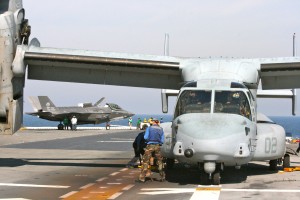
Additionally, with combatant commanders currently asking for more amphibious capabilities, it is time to think about a two ship ARG/MEU construct in place of the current three ship ARG/MEU.
This would allow the naval forces as a whole significantly to increase the total number of ARG/MEUs that could be globally deployed. With every combatant commander desiring more and more amphibious capability, it only seems likely we are heading towards this course of action.
If lack of amphibious lift becomes too much of a concern, the ARG/MEUs can be augmented with maritime pre-positioning ships (MPS), joint high speed vessels (JHSV) or even littoral combat ships (LCS).
All three of these unique capabilities (MPS, JHSV, LCS) need to be fully integrated into the amphibious community. They simply offer too much capability to be left out.
Finally, Marine General Officer billets should be permanently established on Navy Fleet staffs. Currently Colonels are the senior Marine representatives on Navy Fleet staffs. The Council of Colonels is doing great work, but having a Marine General Officer on a Fleet staff would absolutely complete the total blue-green integration piece.
In turn, Navy Flag Officers should be assigned to Marine Corps Forces staffs; again, fully completing the blue-green integration. Both of these measures would enhance the establishment of a true blue-green combined forces maritime component commander (CFMCC) staff at Fleet and higher levels of command.
Again, according to General Amos from his CSIS address available above: “Amphibious forces provide a range of capabilities from the sea. We can loiter unseen over the horizon or provide a visible deterrent. We can temporarily work ashore building strong partnerships, and then swiftly re-embark that same force to respond to a different crisis.”
Conclusion
The blue-green team has overcome many obstacles over the past few years and has met the Commandant of the Marine Corps vision of reinvigorating our amphibious community.
Our ARG/MEUs continue to do great things in the littorals and our ESG/MEBs are developing partnerships that truly never existed before. Due to large scale amphibious exercises like BOLD ALLIGATOR and DAWN BLITZ, the Navy-Marine Corps team continues to fully integrate and get better and better each day.
The future looks exceptionally bright for the naval service with many opportunities for continued integration and success.
Through aggressive but focused measures, the blue-green team can continue to improve its performance and optimize their integrated efforts.
Col Bradley E. Weisz is currently assigned as the Deputy Commander, Expeditionary Strike Group TWO, United States Fleet Forces Command, Little Creek, Virginia. His background in the Marine Corps is aviation command and control.
We have had the opportunity to interview Col. Weisz on a variety of issues discussed here:
https://sldinfo.com/the-coming-of-the-uss-america-to-an-expeditionary-strike-group-esg/
https://sldinfo.com/the-coming-of-the-america-class-warship-to-the-usn-usmc-blue-green-team/
https://sldinfo.com/shaping-c5isr-for-the-fleet-the-case-of-uss-mount-whitney/
https://sldinfo.com/the-evolution-of-the-seabase-shaping-engagement-flexibility/
https://sldinfo.com/the-logistical-impact-of-seabasing/
https://sldinfo.com/the-way-ahead-after-bold-alligator-2012/
https://sldinfo.com/esg-2-prepares-for-bold-alligator-2012/
And for our Special Reports on USMC innovation associated with the new Aviation Assets and on The Bold Alligator 2012 Exercise sees the following:
https://sldinfo.com/the-ace-of-the-future-yuma-and-beyond-2/


